Ladybugs, commonly known as ladybirds in Great Britain or lady beetles in other parts of the world, are widespread insects in the family Coccinellidae. There are more than 5,000 described species of small to medium-sized lady beetles. They come in different colors and patterns, but the seven-spotted ladybugs with glossy, red-and-black bodies are the most common ones.
Most ladybugs have oval, oblong oval, or dome-shaped bodies with six short legs and range in size from 0.03-0.7 inches (0.8 to 18 mm) long. Depending on the species, they can have unique stripes, spots, or no markings. Although they appear colorful to humans, their markings protect them from predators by warning them that they are distasteful.
Ladybugs inhabit many habitats, including suburbs, cities, forests, grasslands, and rivers. During winter, ladybugs hibernate in warm, secluded places, such as under the rocks, in rotting logs, or even inside houses.
Despite their distinct appearance, ladybugs are often confused with other bugs. However, ladybugs behave differently compared to other insects. This article examines colorful bugs that look like ladybugs and how you can differentiate them. Read on for more information!
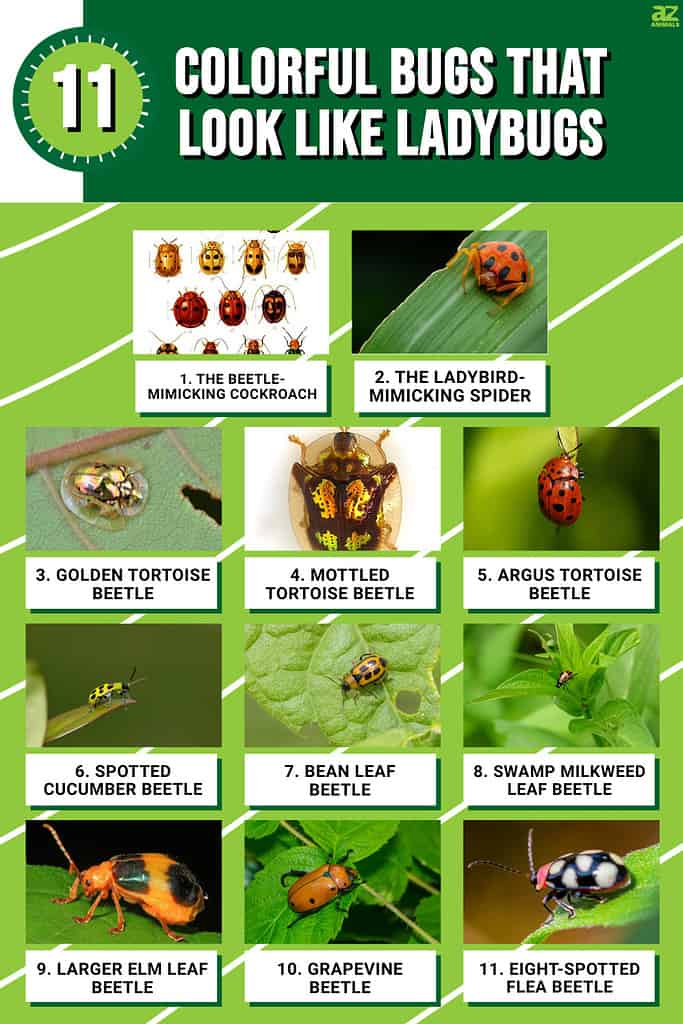
1. The Beetle-Mimicking Cockroach

Beetle-mimicking cockroaches are in the
Prosoplectagenus.
©Horace Knight / Public domain, via Wikimedia Commons – License
| The Beetle-Mimicking Cockroach | |
|---|---|
| Scientific Name | Prosoplecta (genus) |
| Color | Black, grey, yellow, and brown |
| Size | Up to 1.5 inches (4 cm) long |
| Habitat | Prefer warm places, such as storerooms, kitchens, leaf litter, under log piles, and among debris |
Although many cockroaches are brown or black in appearance, a few, particularly those in the Prosoplecta genus, resemble ladybugs. Like seven-spot ladybugs, numerous Prosoplecta cockroaches have reddish bodies with black spots. Besides, a few Asian cockroaches in the genus have bright orange bodies similar to those of lady beetles.
2. The Ladybird-Mimicking Spider

Ladybird-mimicking spiders have yellow-orange legs.
©hellomumu/Shutterstock.com
| The Ladybird-Mimicking Spider | |
|---|---|
| Scientific Name | Paraplectana (genus) |
| Color | Orange-red or yellow-orange |
| Habitat | Range from rainforests and deserts to backyards and everything in between |
Spiders in the Paraplectana genus, such as the Paraplectana tsushimensis, are also very similar to ladybugs. They have orange-red or yellow-orange dome-shaped bodies with black marks, and their heads are yellow-orange and have no marks.
On the other hand, ladybugs have black heads. Besides, most ladybugs have all-black legs, but ladybird-mimicking spiders have yellow-orange legs.
3. Golden Tortoise Beetle
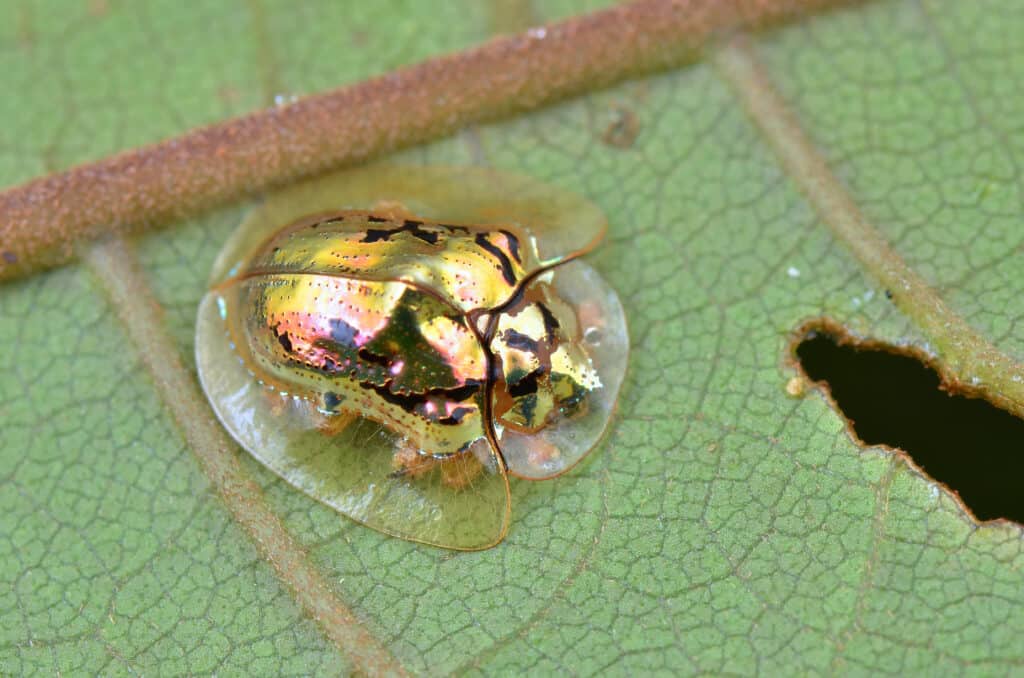
Golden tortoise beetles have a distinct golden color that changes depending on the situation they find themselves in.
©SIMON SHIM/Shutterstock.com
| Golden Tortoise Beetle | |
|---|---|
| Scientific Name | Charidotella sexpunctata |
| Color | Golden |
| Size | 0.2 to 0.3 inches (5 to 7 mm) |
| Habitat | Gardens, forests, or bushes |
Golden tortoise beetles are a species of beetles in the Chrysomelidae family. These beetles get their name from their mirror-like golden bodies, but they can also be reddish-brown with black spots. They closely resemble ladybugs in shape and size. Their distinct golden color changes depending on the situation they find themselves in. For example, they may become red-brown during mating. Color changes can also be observed when these beetles hydrate or sense danger.
4. Mottled Tortoise Beetle
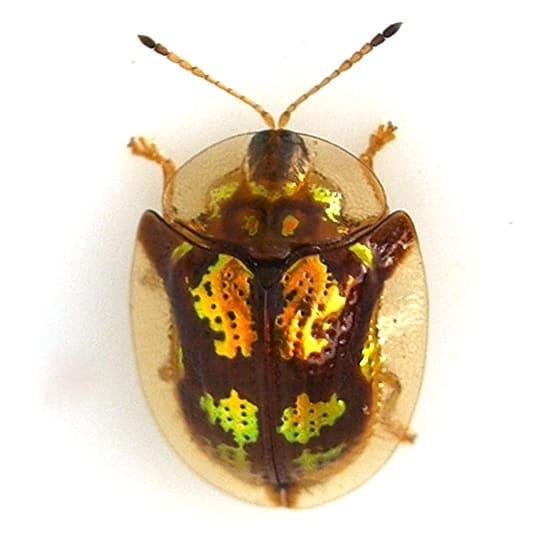
Mottled tortoise beetles are commonly found in Central and North America.
©Ilona Loser / CC BY-SA 3.0, via Wikimedia Commons – License
| Mottled Tortoise Beetle | |
|---|---|
| Scientific Name | Deloyala guttata |
| Color | Gold, brown, black, yellow, green, and orange |
| Size | 0.2 inches |
| Habitat | Fields, meadows, gardens, lawns, and yards |
Mottled tortoise beetles are another species in the family Chrysomelidae. These beetles don’t have dome-shaped bodies like ladybugs. Their close resemblance is typically linked to their small heads and stripe-like markings on their shiny golden backs. Mottled tortoise beetles are commonly found in Central and North America.
5. Argus Tortoise Beetle

The Argus tortoise beetle closely resembles a ladybug in terms of body size, body shape, and markings on its back.
©iStock.com/bookguy
| Argus Tortoise Beetle | |
|---|---|
| Scientific Name | Chelymorpha cassidea |
| Color | Yellow to bright red with black spots |
| Size | 0.35 to 0.47 inches (9 to 12 mm) |
| Habitat | Meadows and roadsides |
The Argus tortoise beetle, also known as the milkweed tortoise beetle, is a leaf beetle species in the Chrysomelidae family. Its name comes from Argus Panoptes, the Greek mythological figure, a creature with multiple eyes. It’s one of the largest leaf beetles native to North America and is best known for having a yellow-red or dark yellow body with black spots on its back.
The Argus tortoise beetle closely resembles a ladybug in terms of body size, body shape, and markings on its back. However, Argus tortoise beetles can stretch their heads the way turtles do, making them different from ladybugs.
6. Spotted Cucumber Beetle

Spotted cucumber beetles rarely grow larger than 0.2 inches.
©iStock.com/Brett_Hondow
| Spotted Cucumber Beetle | |
|---|---|
| Scientific Name | Diabrotica undecimpunctata |
| Color | Greenish-yellow with black spots |
| Size | 0.2 inches (0.5 cm) |
| Habitat | Cucumber and squash crops |
Spotted cucumber beetles resemble yellow ladybugs, and they are greenish-yellow with black spots. Their small black heads further mimic the physical traits of most ladybugs. However, unlike the dome-shaped ladybugs, spotted cucumber beetles rarely grow larger than 0.2 inches. In comparison, some ladybug species can reach 0.7 inches long.
7. Bean Leaf Beetle
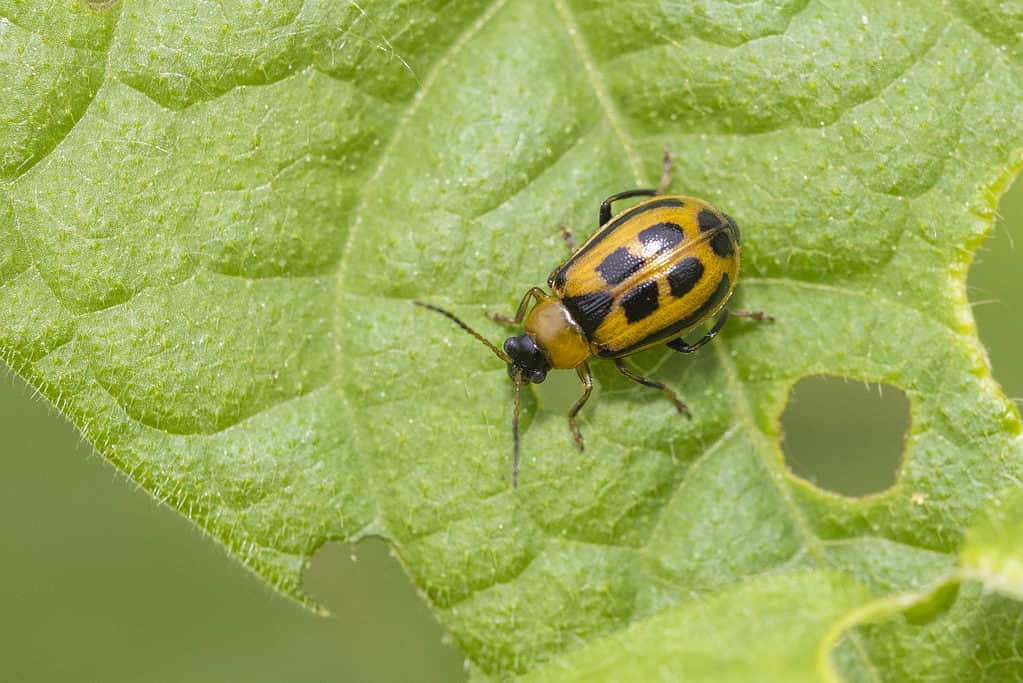
The bean leaf beetle has four black spots on its back and a non-spotted morph.
©iStock.com/mirceax
| Bean Leaf Beetle | |
|---|---|
| Scientific Name | Cerotoma trifurcata |
| Color | Red, gold, or yellow with black spots |
| Size | 0.14 to 0.22 inches (3.5 to 5.5 mm) |
| Habitat | Crop fields and woodlot leaf litter |
The bean leaf beetle is a beetle species in the family Chrysomelidae that’s commonly found in bean, alfalfa, and soy crops. It has a golden coloring with black spots, which is why it’s often confused with many ladybug species.
The bean leaf beetle has four black spots on its back and a non-spotted morph. However, unlike a ladybug’s head, which is usually spotted, bean leaf beetle heads are always black.
8. Swamp Milkweed Leaf Beetle
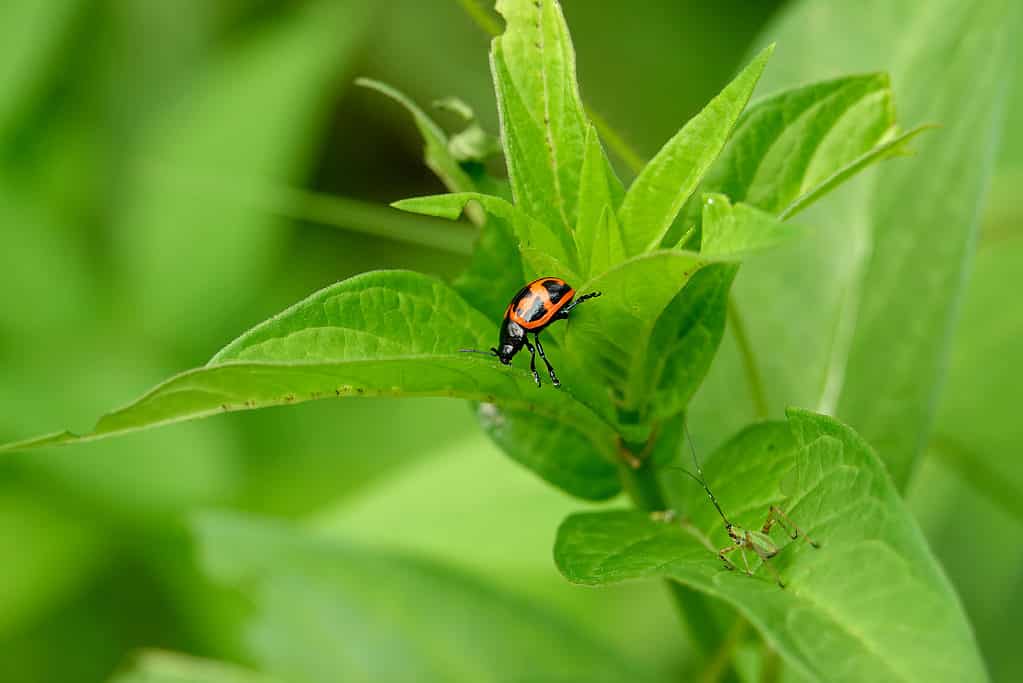
Swamp milkweed leaf beetles and ladybugs have similar sizes.
©iStock.com/ErikAgar
Swamp Milkweed Leaf Beetle | |
|---|---|
| Scientific Name | Labidomera clivicollis |
| Color | Red or orange with black marks |
| Size | About 0.3 to 0.4 inches (8 to 11 mm) |
| Habitat | Roadsides or grassy areas, preferably on the milkweeds it eats |
The swamp milkweed leaf beetle is another leaf beetle species in the Chrysomelidae family. It’s often confused with the red ladybug species due to its similar dome-shaped body with orange or red coloring and black spots. Besides, swamp milkweed leaf beetles and ladybugs have similar sizes.
However, looking closely, you can differentiate the two species by observing their black marks. Most swamp milkweed leaf beetles have considerably larger spots than ladybugs.
9. Larger Elm Leaf Beetle
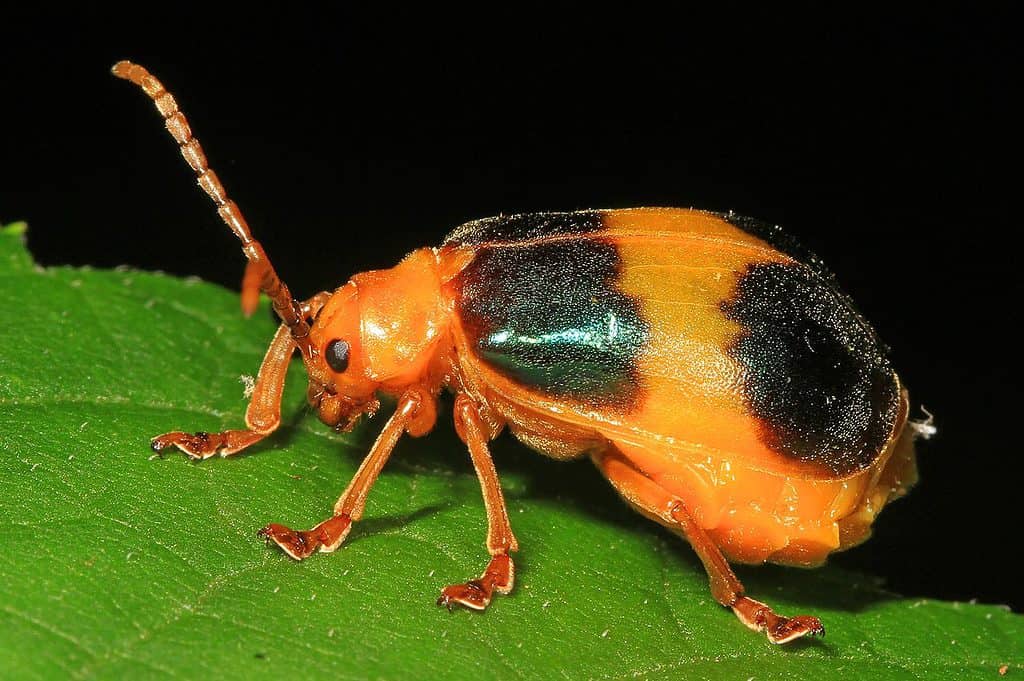
Larger elm leaf beetles are rather pear-shaped than dome-shaped.
©Judy Gallagher / CC BY 2.0, via Wikimedia Commons – License
| Larger Elm Leaf Beetle | |
|---|---|
| Scientific Name | Monocesta coryli |
| Color | Yellow-orange body with black spots |
| Size | 0.4 to 0.6 inches (10 to 16 mm) |
| Habitat | Forests |
The larger elm leaf beetle is the only species of the large neotropical genus Monocesta found in the United States. It is commonly found in forests. Like ladybugs, this species has a yellow-orange body and four large dark marks. Although their body shape is similar to that of ladybugs, larger elm leaf beetles are rather pear-shaped than dome-shaped.
10. Grapevine Beetle
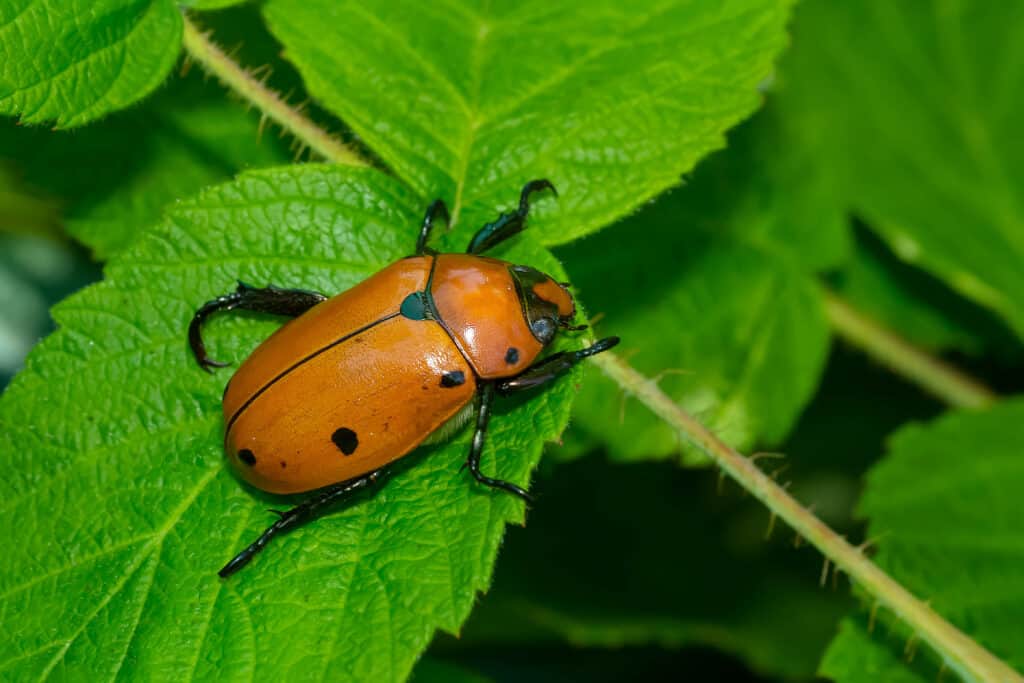
The grapevine beetle is also known as a spotted June beetle or a spotted pelidnota.
©Paul Reeves Photography/Shutterstock.com
| Grapevine Beetle | |
|---|---|
| Scientific Name | Pelidnota punctata |
| Color | Yellow |
| Size | 1 to 1.2 inches (25.4 to 30.5 mm) |
| Habitat | Forests and woods |
The grapevine beetle, also known as the spotted June beetle or spotted pelidnota, is a type of scarab beetle that resembles a ladybug. It has an off-yellow color with four small black marks on each side. Like most ladybugs, grapevine beetles also have all-black legs.
11. Eight-Spotted Flea Beetle
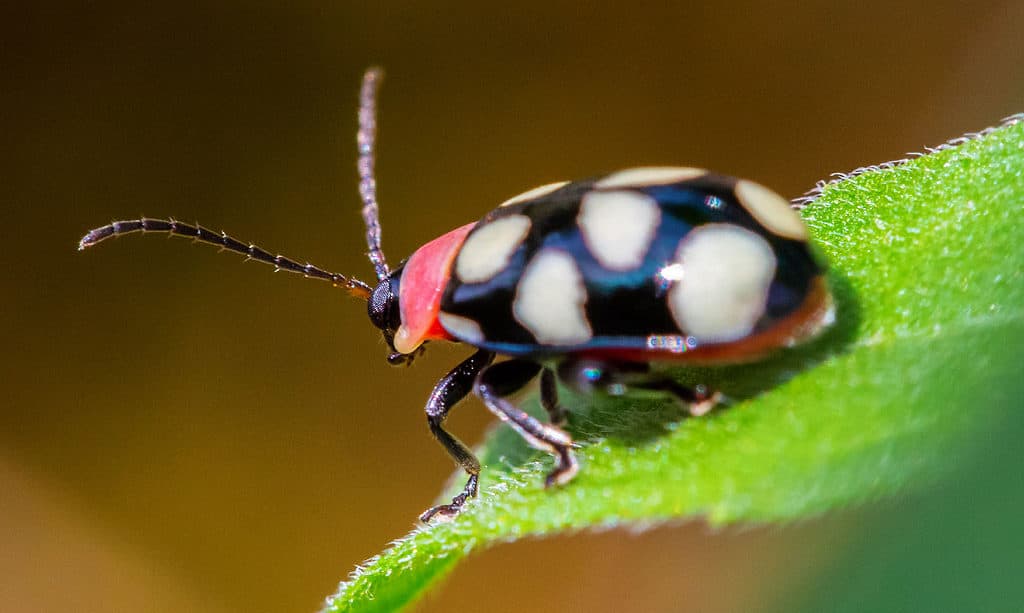
The eight-spotted flea beetle has a black body with white spots, almost similar to those of ladybugs.
©eera5607/Shutterstock.com
| Eight-Spotted Flea Beetle | |
|---|---|
| Scientific Name | Omophoita cyanipennis |
| Color | Black body and white spots |
| Size | Around 0.7 inch (18 mm) |
| Habitat | Common in leaf litter and wooded areas |
The eight-spotted flea beetle is a small insect in the family Chrysomelidae that is commonly sighted in North America, Central America, and the Caribbean Sea. It has a black body with white spots, almost similar to those of ladybugs. Moreover, like most ladybugs, the eight-spotted flea beetle has a spotted head, which usually features only one white mark. Moreover, its body is more elongated than the dome-shaped ladybug’s.
Summary of 11 Colorful Bugs That Look Like Ladybugs
Here’s a recap of the 11 bugs we looked at that resemble ladybugs.
| Number | Bug | Scientific Name | Color |
|---|---|---|---|
| 1 | The Beetle-Mimicking Cockroach | Prosoplecta (genus) | Black, grey, yellow, and brown |
| 2 | The Ladybird-Mimicking Spider | Paraplectana (genus) | Orange-red or yellow-orange |
| 3 | Golden Tortoise Beetle | Charidotella sexpunctata | Golden |
| 4 | Mottled Tortoise Beetle | Deloyala guttata | Gold, brown, black, yellow, green, and orange |
| 5 | Argus Tortoise Beetle | Chelymorpha cassidea | Yellow to bright red with black spots |
| 6 | Spotted Cucumber Beetle | Diabrotica undecimpunctata | Greenish-yellow with black spots |
| 7 | Bean Leaf Beetle | Cerotoma trifurcata | Red, gold, or yellow with black spots |
| 8 | Swamp Milkweed Leaf Beetle | Labidomera clivicollis | Red or orange with black marks |
| 9 | Larger Elm Leaf Beetle | Monocesta coryli | Yellow-orange body with black spots |
| 10 | Grapevine Beetle | Pelidnota punctata | Yellow |
| 11 | Eight-Spotted Flea Beetle | Omophoita cyanipennis | Black body and white spots |
The photo featured at the top of this post is © iStock.com/DE1967
Sources
- Science Direct, Available here: https://www.sciencedirect.com/science/article/pii/B9780123741448001569
- Wikipedia, Available here: https://en.wikipedia.org/wiki/Diabrotica_undecimpunctata
Thank you for reading! Have some feedback for us? Contact the AZ Animals editorial team.






